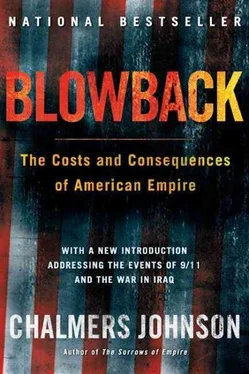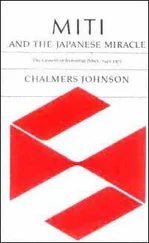Chalmers Johnson - Blowback, Second Edition - The Costs and Consequences of American Empire
Здесь есть возможность читать онлайн «Chalmers Johnson - Blowback, Second Edition - The Costs and Consequences of American Empire» весь текст электронной книги совершенно бесплатно (целиком полную версию без сокращений). В некоторых случаях можно слушать аудио, скачать через торрент в формате fb2 и присутствует краткое содержание. Год выпуска: 0101, ISBN: 0101, Издательство: Macmillan, Жанр: Старинная литература, на английском языке. Описание произведения, (предисловие) а так же отзывы посетителей доступны на портале библиотеки ЛибКат.
- Название:Blowback, Second Edition: The Costs and Consequences of American Empire
- Автор:
- Издательство:Macmillan
- Жанр:
- Год:0101
- ISBN:9780805075595
- Рейтинг книги:5 / 5. Голосов: 1
-
Избранное:Добавить в избранное
- Отзывы:
-
Ваша оценка:
- 100
- 1
- 2
- 3
- 4
- 5
Blowback, Second Edition: The Costs and Consequences of American Empire: краткое содержание, описание и аннотация
Предлагаем к чтению аннотацию, описание, краткое содержание или предисловие (зависит от того, что написал сам автор книги «Blowback, Second Edition: The Costs and Consequences of American Empire»). Если вы не нашли необходимую информацию о книге — напишите в комментариях, мы постараемся отыскать её.
Blowback, Second Edition: The Costs and Consequences of American Empire — читать онлайн бесплатно полную книгу (весь текст) целиком
Ниже представлен текст книги, разбитый по страницам. Система сохранения места последней прочитанной страницы, позволяет с удобством читать онлайн бесплатно книгу «Blowback, Second Edition: The Costs and Consequences of American Empire», без необходимости каждый раз заново искать на чём Вы остановились. Поставьте закладку, и сможете в любой момент перейти на страницу, на которой закончили чтение.
Интервал:
Закладка:
During this period and with considerable American and Japanese support, Suharto overcame starvation on the main island of Java and led the country into sustained economic growth. However, Indonesia was clobbered by the 1997 financial crisis that depressed its stock and currency values to as much as 80 percent below precrisis levels. Because of misguided policies by the United States and the International Monetary Fund, discussed later in this chapter and in chapter 9, the number of people in Indonesia living below the poverty line grew in a matter of months from twenty-seven million to over a hundred million (half the population), and thirty years of economic gains were wiped out. Hundreds of thousands of workers lost their jobs. The country remains destitute and threatened with possible disintegration, even though its political life has been invigorated by the return of democracy after thirty-two years of one-man rule. Thus far, the blowback from American policies in Indonesia has affected primarily Indonesians and, in particular, the Chinese minority in the country, which is also the entrepreneurial elite. Americans have not been affected, but this is unlikely to last as Indonesia emerges from its present trauma and starts to assess what happened to it and who was responsible.
The bloody ouster of General Suharto as president of Indonesia and as one of America’s favorite dictators in East Asia is a case study in the dangers of JCET programs. Between May 13 and May 15, 1998, nearly 1,200 people were killed in Jakarta in rioting that led to the resignation of General Suharto. It was subsequently revealed that during this “rioting” at least 168 women and girls, most of them of Chinese ancestry, had been raped by “organized groups of up to a dozen men” and that 20 had died during or after the assaults. 10It was also revealed that groups of men had traveled the city in vehicles inciting the crowds to violence. Many Indonesians accused the army and its clandestine security forces—the elite commando regiment Kopassus, known as the “red berets”—of committing these acts. (The army later did publicly acknowledge that members of its special forces had been involved in the “disappearances” of opposition activists in the weeks before the riots.)
In his years of rule, General Suharto had long had a reputation for using Kopassus, run from 1995 on by his son-in-law Lt. Gen. Prabowo Soemitro Subianto, to abduct, torture, and kill dissidents and political rivals. In 1990, for instance, he declared the western area of the island of Sumatra around Aceh a “military operational zone” in order to suppress an Islamic secessionist movement. He then sent in Kopassus units. Hundreds, perhaps thousands of people in the area “disappeared” and are presumed to have been executed by Kopassus. In August 1998, after Suharto’s ouster, General Wiranto (also just one name), commander in chief of the Indonesian armed forces, flew to Sumatra, inspected mass graves, apologized for “abuses committed by the military there,” and ordered all combat troops pulled out of the province. Under Suharto’s order, Kopassus had carried out similar campaigns in the past in East Timor and Irian Jaya (New Guinea).
In January 1998 some Kopassus battalions from western Sumatra and New Guinea were transferred to Jakarta, where during the following three months at least fourteen activists against Suharto also “disappeared.” After Suharto’s fall, the army high command itself concluded that Kopassus was responsible for at least nine kidnappings in the capital. Five of the kidnappees are still unaccounted for and presumed dead. Singled out for immediate responsibility was one of General Prabowo’s deputies, Colonel Chairawan, commander of the plainclothes Kopassus Group 4. Before his arrest, Chairawan, a figure well known to the American military, told Nation magazine correspondent Allan Nairn that his primary contact at the U.S. embassy was Colonel Charles McFetridge, the DIA attaché. 11Nonetheless, the orders for these kidnappings and executions probably came from Suharto himself.
After the 1998 rioting and the mass exodus from Indonesia of those Chinese who could afford to emigrate, the elites of Indonesia, no longer as threatened by police-state methods as they were under Suharto, demanded an investigation. The successor government of President B. J. Habibie appointed an eighteen-member investigating team, including representatives of the government, private groups, the armed forces, and the Indonesian Commission on Human Rights. In its report of November 3, 1998, the team concluded that much of the violence had been organized and deliberately provoked by the armed forces, probably in order to create enough of the look of chaos to make a military coup seem a plausible and acceptable step. The Indonesian military had earlier claimed that it could find no evidence of any rapes at all during the disturbances, whereas the report confirmed that seventy-six women, virtually all of Chinese descent, had been raped or otherwise sexually assaulted. The initial Chinese community’s claim of more than twice that number may actually be closer to the truth, since many women were understandably reluctant to reveal what had happened to them. The report also charged two generals, Lieutenant General Prabowo of Kopassus and Major General Syafrie Samsuddin, head of the Jakarta Military Command and a Prabowo aide, with responsibility for organizing the riots and killings. Officials of the Indonesian government, who had initially ordered the report, failed to show up for the meeting at which it was delivered. 12
The Indonesian armed forces, known as ABRI, have long been the chosen instrument of American foreign policy in the area, bolstering Suharto’s stoutly anti-Communist regime. In 1965, when General Suharto was in the process of coming to power, the United States provided ABRI with lists of suspected Communists, over half a million of whom were slaughtered. It also publicly endorsed ABRI’s 1975 invasion of East Timor and the subsequent elimination of two hundred thousand East Timorese through what the State Department in its 1996 Human Rights Report calls “extrajudicial killings.” From the time of the European voyages of “discovery,” East Timor, an island in the Indonesian archipelago, was a colony of Portugal. When in the mid-1970s a revolution in Portugal precipitated the decision by Lisbon to liquidate the remnants of its empire, the heavily Catholic population of East Timor sought autonomy or independence. Indonesia instead annexed it. Rebellion and repression have been endemic there ever since. As an unexpected benefit of the end of the Suharto era, President Habibie offered East Timor the opportunity to affiliate with Indonesia or become independent. East Timor voted for independence, but army-incited murders and scorchedearth tactics have also plagued the territory.
When the 1997 financial crisis spread to Indonesia and it became apparent that the International Monetary Fund’s bailout policies were likely to end the seventy-six-year-old Suharto’s further usefulness to the United States, American policy remained focused on maintaining control inside Indonesia through its backing of the 465,000-man-strong ABRI. Indonesia totally lacks external enemies. Its armed forces are therefore devoted almost entirely to maintaining “internal security.” During most of the Suharto years, the United States actively trained ABRI special forces in a variety of what the New York Times calls “specialized acts of warfare and counterinsurgency.” 13The CIA and the Defense Intelligence Agency have long maintained close ties with ABRI, which has often been implicated in cases of torture, kidnapping, and assassination. Special Warfare , the professional magazine of the John F. Kennedy Special Warfare School at Fort Bragg, North Carolina, calls Kopassus the “guarantor of national unity in the face of many threats and challenges.” 14
Читать дальшеИнтервал:
Закладка:
Похожие книги на «Blowback, Second Edition: The Costs and Consequences of American Empire»
Представляем Вашему вниманию похожие книги на «Blowback, Second Edition: The Costs and Consequences of American Empire» списком для выбора. Мы отобрали схожую по названию и смыслу литературу в надежде предоставить читателям больше вариантов отыскать новые, интересные, ещё непрочитанные произведения.
Обсуждение, отзывы о книге «Blowback, Second Edition: The Costs and Consequences of American Empire» и просто собственные мнения читателей. Оставьте ваши комментарии, напишите, что Вы думаете о произведении, его смысле или главных героях. Укажите что конкретно понравилось, а что нет, и почему Вы так считаете.










